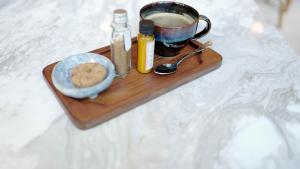
The Importance of Coffee Bloom in Brewing the Perfect Cup
The Importance of Coffee Bloom in Brewing the Perfect Cup
- Adam Smith
- 20-08-2024
- 20-08-2024
- 988 views
- Coffee Health, Coffee Shop

Introduction
In the quest to brew the perfect cup of coffee, there are many variables to consider — from grind size and water temperature to brewing method and coffee-to-water ratio. Yet, one often overlooked aspect of the brewing process is the “coffee bloom.” Though it might sound like something reserved for coffee connoisseurs, the coffee bloom is crucial in achieving optimal flavor extraction and ensuring a well-balanced brew. Understanding what the coffee bloom is, why it happens, and how to control it can elevate your coffee experience and bring out the best in every cup.
In this blog, we’ll explore the science behind the coffee bloom, its impact on flavor, and how you can incorporate it into your brewing routine to make your coffee shine.
What Is Coffee Bloom?
The coffee bloom refers to the initial phase of brewing when hot water first comes into contact with ground coffee. During this phase, carbon dioxide (CO2) that’s trapped in the coffee beans is released. The release of CO2 causes the coffee grounds to swell and “bloom,” creating bubbles and a frothy appearance on the surface. This phase typically lasts for 30 to 45 seconds, and though it may seem simple, it’s vital for unlocking the full flavor potential of your coffee.
Why Does Coffee Bloom Occur?
To understand why coffee bloom occurs, we need to consider the roasting process. Coffee beans are filled with gases, mainly CO2, that form during roasting. Freshly roasted beans, in particular, contain a higher concentration of these gases. When you grind the beans and pour hot water over them, the water forces the trapped CO2 to escape, resulting in the blooming effect. The release of gases is most visible during this phase because the pressure from the hot water forces the gas out rapidly.
This process is essential for flavor development because the gases, if not released, can create a barrier that prevents water from fully saturating the coffee grounds. When CO2 escapes during the bloom, it clears the way for water to extract the soluble compounds that make up the coffee’s flavor profile.
How Bloom Affects Flavor Extraction
The bloom phase is critical to achieving optimal flavor extraction. By allowing the gases to escape, the water can make better contact with the coffee grounds, leading to more even extraction. Even extraction ensures that the flavors are well-balanced, bringing out the rich and complex notes of the coffee without over-extracting bitter compounds or under-extracting the pleasant, acidic flavors.
When the bloom is rushed or skipped altogether, the result can be an uneven extraction, which often leads to a cup that tastes flat, sour, or bitter. If you’re brewing freshly roasted coffee and notice that your cup isn’t as flavorful as you’d like, insufficient blooming might be the culprit.
How to Bloom Coffee: A Step-by-Step Guide
Incorporating a proper coffee bloom into your brewing routine is straightforward and can be done with any brewing method that involves pouring hot water over the grounds. Here’s how you can bloom your coffee:
- Measure and Grind Your Coffee Beans: Start with fresh, high-quality beans and grind them just before brewing to preserve the natural oils and gases. Measure the amount of coffee you need based on your preferred coffee-to-water ratio.
- Preheat Your Equipment: Preheat your brewing equipment, such as a pour-over, Chemex, or French press, by rinsing it with hot water. This helps maintain a stable brewing temperature.
- Pour Water for the Bloom: Begin by pouring a small amount of hot water (about twice the weight of the coffee grounds) over the coffee. The water should be just off the boil, ideally around 200°F (93°C).
- Wait for 30-45 Seconds: Allow the coffee to bloom for 30 to 45 seconds. You’ll notice the coffee grounds rise and bubble as the gases escape. During this time, gently stir the coffee to ensure even saturation of all grounds.
- Continue Brewing: After the bloom, continue with your brewing process by adding the remaining water in a slow, steady pour, making sure the coffee is evenly saturated.
Coffee Bloom Across Brewing Methods
The coffee bloom is important no matter which brewing method you prefer. However, some methods highlight this phase more than others:
- Pour-Over: Pour-over methods, such as the Hario V60 or Chemex, offer a clear view of the bloom, making it easy to observe and control. Since you manually pour the water, you can adjust the amount and flow rate to optimize the bloom.
- French Press: In a French press, blooming is just as important. After pouring a small amount of water over the grounds, stirring helps to ensure even extraction. Once bloomed, you can continue with the brewing process.
- Espresso Machines: Espresso machines don’t offer much of a visual bloom since the process is pressurized. However, allowing freshly ground coffee to degas before tamping and pulling the shot can help with even extraction.
- Automatic Drip Machines: Many automatic drip machines don’t provide an opportunity for blooming unless they have a specific pre-infusion setting. However, some machines allow you to manually pause the brewing process after the first few seconds to allow for a bloom before continuing.
Factors That Influence the Bloom
While blooming is a relatively simple process, a few factors can influence how effective it is:
- Freshness of the Coffee Beans: The fresher the beans, the more CO2 they will release. Beans that are too old or stale won’t bloom as noticeably, resulting in less flavor extraction. For the best results, use beans that have been roasted within the last two weeks.
- Grind Size: The grind size can affect how well the coffee blooms. A coarser grind may release gases more slowly, while a finer grind will bloom faster. Experiment with different grind sizes to find the one that works best for your brewing method.
- Water Temperature: The temperature of the water can impact the bloom. Water that’s too hot may cause the gases to escape too quickly, while water that’s too cool may slow down the bloom. Aim for water between 195°F and 205°F (90°C to 96°C) for optimal results.
The Science of Coffee Bloom and Freshness
The coffee bloom is an indicator of freshness. Coffee beans contain various volatile compounds that contribute to their flavor and aroma. When the beans are freshly roasted, they contain a higher concentration of these compounds, including CO2. As coffee ages, it loses its ability to bloom because the volatile compounds dissipate, leading to a flatter taste.
By paying attention to the bloom, you can gauge the freshness of your coffee and adjust your brewing technique accordingly. A lackluster bloom may be a sign that your beans are past their prime and should be replaced for a fresher, more flavorful brew.
Conclusion
The coffee bloom may seem like a minor step in the brewing process, but it has a significant impact on the flavor and quality of your coffee. By allowing the gases trapped in the coffee grounds to escape during the bloom phase, you create the ideal conditions for even extraction and balanced flavor development. Whether you’re a pour-over enthusiast or a French press devotee, taking the time to bloom your coffee can elevate your morning cup and make all the difference in taste. So next time you brew a cup of coffee, remember to give it a bloom for the perfect flavor experience.






















